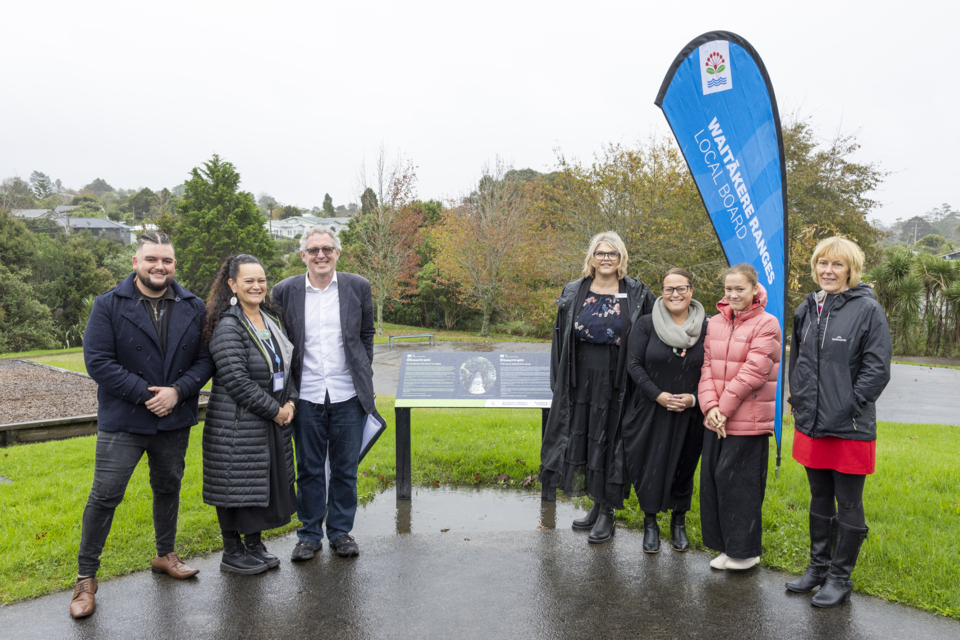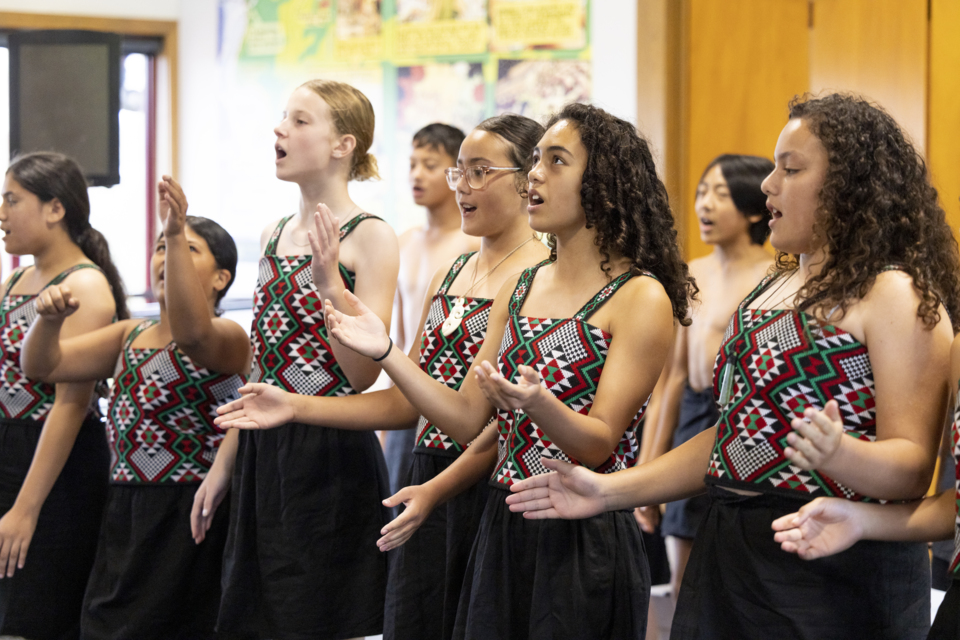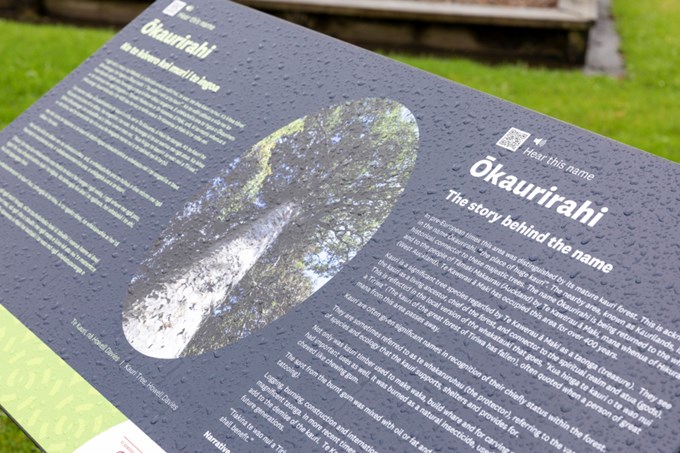Names and narratives that reclaim Māori identity and restore mana and mauri (life force) to the whenua (land), through the restoration of the Māori language, are being returned to the whenua in parks across communities in the Waitākere Ranges Local Board area.
In June 2021 the local board adopted 19 names provided by local iwi, Te Kawerau ā Maki [PDF]. This was part of the council’s cultural identity programme, Te Kete Rukuruku.
Ōkauriraki / Ceramco Park became the first park in the Waitākere Ranges Local Board area to showcase new signs bearing the dual name, celebrated through an event at the park.
“Can I thank Te Kawerau ā Maki for this gift. It is a name that provides a perfect description of the area in its previous form. It is something for us to reflect on. This is important to our community and as a local board, it is an honour to be playing a part in restoring mana to the land and to the community,” says Waitākere Ranges Local Board chair, Greg Presland.
For Te Kawerau a Maki, who returned this name to the park, the ceremony was a chance to further share the story and celebrate the adoption of these names with the community.
“Te Kawerau a Maki see this as an opportunity to share our current and historical connection to the whenua. Returning the original name of Ōkaurirahi to this area reinforces the deep connection that we, as mana whenua, have to Glen Eden,” says Robin Tua-Gordon from Te Kawerau a Maki.
For now it will be the only park in the area to have a full suite of bilingual signs. Park name signs in the other sites selected for dual naming are being updated over time, with both their Māori and English names, as they are scheduled to be replaced.

L-R Tyler Taua-Gordon, Robin Taua-Gordon, Greg Presland, Linda Potauaine, Josie Wall, Milla-Jayne Wall, Liz Manley
The story behind the name Ōkaurirahi
In pre-European times this area was distinguished by its mature kauri forest. This is acknowledged in the name Ōkaurirahi, “the place of huge kauri”. The nearby area, known as Kaurilands, is also a historical connector to these majestic trees.
The name Ōkaurirahi is being returned to the whenua and to the people of Tāmaki Makaurau (Auckland) by Te Kawerau ā Maki, mana whenua of Hikurangi (West Auckland).
Te Kawerau ā Maki has occupied this area for over 400 years.
Kauri is a significant tree species regarded by Te Kawerau ā Maki as a taonga (treasure).
They see the kauri as a living ancestor, chief of the forest, and connector to the spiritual realm and atua (gods). This is reflected in the local version of the whakataukī that goes, "Kua hinga te kauri o te wao nui a Tiriwa" (The kauri of the great forest of Tiriwa has fallen), often quoted when a person of great mana from this area passes away.
Kauri are often given significant names in recognition of their chiefly status within the forest. They are sometimes referred to as te whakaruruhau (the protector), referring to the vast number of species and ecology that the kauri supports, shelters and provides for.
Not only was kauri timber used to make waka, build whare and for carving pou, the kāpia (gum) had important uses as well. It was burned as a natural insecticide, used to start fires and even chewed like chewing gum. The soot from the burnt gum was mixed with oil or fat and then used in tā moko (traditional Māori tatooing).
Logging, burning, construction and international trade contributed to the decline of these magnificent taonga. In more recent times, introduced animal pests and disease have continued to add to the demise of the kauri. Te Kawerau ā Maki, as kaitiaki, continues to protect the forest for future generations.
“Tiakina te wao nui a Tiriwa hei oranga mōu”, Treasure the vast domain of Tiriwa and in turn you shall benefit.”
Narrative also provided by Te Kawerau ā Maki

The event also included Waiata from local rangatahi
About the Te Kete Rukuruku programme
In 2017 Auckland Council launched the Te Kete Rukuruku (TKR) project.a culture and identity programme to collect and share the stories unique to Māori in Auckland. The programme is led by iwi, in partnership with the council and its local boards.
One component of this is a naming project which will see iwi and hapu names restored. In some cases, these names existed prior to the current names, such as Ōkaurirahi. In other cases they may be more contemporary names that reflect an historical activity of the area prior to European settlement or sometimes have an environmental connection.
Short narratives explaining the significance of the names are also provided by mana whenua that explain the meaning and show the connection to the place being named.
This is one way for local communities to learn about their Māori history, language and culture. It provides a way of protecting and returning the names and the rich mana whenua stories of Auckland – some of which have been lost over many years.
Other local boards currently participating in te Kete Rukuruku are:
- Albert-Eden Local Board
- Devonport-Takapuna Local Board
- Franklin Local Board
- Henderson-Massey Local Board
- Hibiscus and Bays Local Board
- Howick Local Board
- Kaipātiki Local Board
- Māngere-Ōtāhuhu Local Board
- Manurewa Local Board
- Maungakiekie-Tāmaki Local Board
- Ōtara-Papatoetoe Local Board
- Papakura Local Board
- Puketāpapa Local Board
- Whau Local Board
- Waitākere Ranges Local Board
- Waitematā Local Board.
Stay up to date
Want to stay up to date with all the latest news from your area? Sign up for Waitākere Ranges Local Board's E-News and get the latest direct to your inbox each month.


